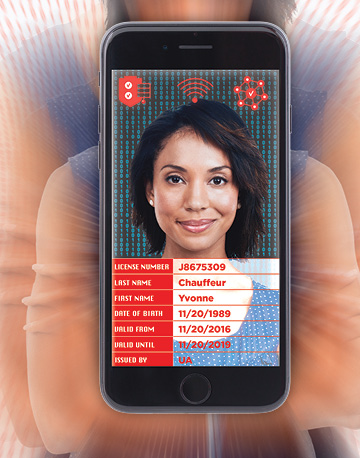An Intelligent Solution
How DMVs are using artificial intelligence to improve service
When doing a title transfer or updating a license to REAL ID, imagine being able to know before your customer comes into the office that not only do they have all the forms they need, but the form information is also accurate and correct. It sounds like a dream, but it is very real and just one of the ways artificial intelligence (AI) can aid motor vehicle departments.
“We piloted intelligent document processing with the REAL ID use case,” says Ajay Gupta, chief digital transformation officer at the California Department of Motor Vehicles. “The customer uploads the documents that prove their identity and we created an AI-augmented process where the AI takes the first stab at processing the documents. If it doesn’t know what to do, we pass it along to the human queue.”
While this is one of the more advanced applications of AI in the DMV space, it gives a glimpse of the future of DMVs—empowering staff to increase efficiency with the aid of technology. And although DMVs have been investigating this technology for years, the coronavirus pandemic has highlighted its importance. With call center volumes booming due to office closures, canceled appointments and a general wariness of the public to visit offices, doing more with less has never been more important for the motor vehicle services industry.
Let’s Have a Chat
Even before the pandemic necessitated a stronger online presence for most DMVs, many jurisdictions had experience with AI technology. One of the most common uses is a website chatbot that can interact with customers and direct them to the right place, ideally without ever talking to a human.
“The No. 1 AI application we’ve seen is chatbots,” says Eric Paternoster, president & CEO at Infosys Public Services, a consulting and technology solutions company that works with DMVs to accelerate their digital transformation. “Chatbots are an ideal way to ease into the process of incorporating AI. If you think about the standard construct of AI—where you go through the process of discover, learn, sense and respond—that is the classic AI sequence that any AI application should follow and it’s easy to comprehend with the chatbot.”
“I think incorporating technology into our process is one of the most important things we’re doing right now,” says Lacey Black, Driver Solutions Manager at the Kansas Department of Revenue. “We need to keep up with the times and if we’re not expanding or implementing new technologies, our interactions with customers aren’t going to be as positive as they can be.”
Black and the Kansas DOR implemented an AI-assisted chatbot on their website about three years ago. Another Kansas agency was already using the technology, so Black and her team got into contact with that agency and brought it to the DOR. “I would say the biggest benefit is the reduction in phone calls,” says Black. “We’ve had a really high answer rate in our call center the past year and I think the chatbot reducing call volume has a lot to do with that.”
Joseph Cotton, bureau chief of customer service at the Florida Department of Highway Safety and Motor Vehicles, had a similar experience with a chatbot when his jurisdiction implemented it in November 2020.
“It literally does 100,000 contacts per month,” he explains. “It allows customers to get answers to their questions, get directed to the appropriate place on our website and facilitate self-service items. It has been a bit of new technology that has been welcomed.”
For jurisdictions that haven’t yet implemented chatbot functionality, but are looking into it, Black and Cotton recommend taking your time with testing to ensure a successful launch. “In Florida, the processes and actions associated with implementation can get nuanced and complex, and the vendors are not going to understand those nuances,” Cotton says. “From a service center standpoint, we have to provide that knowledge. We created the product flows, and after they applied those flows, we would test it to make sure it’s working appropriately. We were pretty engaged in the process.”
Beyond the Bots
While they are by far the most common, chatbots aren’t the only way jurisdictions are taking advantage of AI to solve problems. The South Dakota Motor Vehicle Division uses search engine technology on their website that acts similarly to a chatbot.
“It’s an interactive search engine,” says Ashley Zilverberg, Information & Data Services Supervisor for the South Dakota MVD. “The need for it came from our contact centers. Previously, it was really difficult getting customers where they needed to go on the website. Now, for a lot of things, our agents can help them find what they need more easily.”
Other AI offerings, such as contact center technology that can answer questions and redirect calls to the service center, also share a lot in common with chatbots in that they operate based on a workflow created by the jurisdiction.
“The first AI use case we actively pursued was a chatbot channel on our website,” Gupta says. “And after that, the voice channel came out of necessity because we had a large backlog and were looking for alternatives to work through it. It started with offering the [AI-enabled] smart assistant while customers were waiting on hold, which was successful. Now, we have the smart assistant option right at the front. We are actually working to get our entire IVR [(interactive voice response)] system converted to an AI-based model where customers will be able to speak to the AI using a text-to-speech function.”
Gupta and the California DMV are on the cutting edge of implementing AI technology, going even further than live chat and intelligent document processing. In addition to piloting AI-augmented proctors for virtual written drivers’ exams—the AI would monitor a video feed of the customer taking the test and flag any potential issues for a human to review—the California DMV is also looking into AI to help optimize workforce management.
“It’s a very complex problem,” Gupta says. “We have different classifications, different skill sets, different locations, so how do we optimize our schedule for our workforce? How do we create the flexibility they need? We are looking at solutions that use AI and machine learning at their cores to optimize schedules.”
Making the Case for AI
It’s clear that AI has numerous applications in the motor vehicle space, and those options will only continue to increase as new technologies are developed. However, for many jurisdictions, making the budgetary case for incorporating a new technology can be just as important as that technology’s potential applications.
“In the past year, a lot of DMVs have seen budget constraints with public budgets understandably going to higher priority items like unemployment insurance claims processing or public health initiatives,” Paternoster says. “Maybe they weren’t able to go through with the modernization effort they were planning for in 2020. I think we’ll probably see an explosion in adoption of new technologies from pent-up demand.”
For Florida, budget constraints are part of what helped Cotton make the case for implementing an AI chatbot last year. “The value of technology has gone up,” he says. “We recognize that something else like [the pandemic] could happen again and we want to know how we will be situated in a way to continue operations if it does. That was one of the driving reasons why we adopted the chatbot: We felt the effects of an economy that’s been badly hurt. The dollars we receive are driven by the public and we want to make those dollars as effective as possible. The way to do that is leaning more into technology.”
The Georgia Department of Driver Services is currently in the process of implementing an AI-enabled voice assistant, a project which is largely driven by increased call volume due to the pandemic.
“Since the pandemic started, our call volume has increased by 73% or about 860,000 additional calls,” says Kecia Bivins, Director at the Georgia DDS. “We only have 55 agents and there is no way our agents can meet that demand. We definitely want to leverage this technology to better serve our customers.”
Preparing for the Future
Making the decision to implement an AI-enabled technology is just the beginning. As with any large project undertaken by a motor vehicle department, planning is paramount to success.
“I think the most successful agencies take two often separate approaches and merge them: You do pilots and proofs of concept to test things out properly, but you also take a step back and look at the bigger picture,” Paternoster says. “If you just go ahead and spend a bunch of money and implement a new technology without thinking about how it fits into your organization, you might miss an opportunity to combine the technology with another goal you’re working toward. The best way to look forward is to think holistically about how these technologies can work together to solve different problems more effectively. Once DMVs have this view, they can look at incorporating AI-related requirements into their RFXs for broader modernization and digitization efforts.
“As DMVs navigate to a higher AI maturity level, they’ll be able to leverage automated data-science platforms to analyze different type of data sets—from the traditional licensing and registration records to data from IoT/connected devices and traffic-related information to generate predictive and prescriptive insights, like identification of high-risk drivers.”
From his experience implementing multiple new technologies at the California DMV, Gupta suggests planning ahead, but also starting slowly and learning along with the AI.
“You don’t need to solve all your complex problems right away,” Gupta says. “You want to start small. You also want to plan for treating AI as an employee who’s just learning. This means you need to spend time with it and train it. So you need to be ready to spend the upfront effort to train the models, and also assume that initially it will have below-par throughput as it is learning. You want to make sure your organization is really treating AI as an augmentation rather than a replacement.”
For anyone in the motor vehicle services industry who is wary of involving AI in their workflow, Gupta makes a key point: AI is not here to replace humans, but to augment them. It should relieve customer service agents of the menial and tedious tasks they often spend time on and, therefore, allow them to focus on more complex problems. While AI is currently in its infancy, its value to the motor vehicle services industry will only grow.




